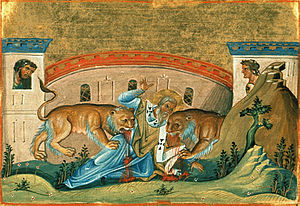
The complete series is archived here.
I am genuinely grateful to Neil for allowing me to present on his blog a series of posts explaining my theory about the letters commonly attributed to Ignatius of Antioch. It should be understood that his permission does not imply that he concurs with the theory or any part of it. These posts will be a condensed, revised version of the main arguments contained in my self-published book “A New Look at the Letters of Ignatius of Antioch and other Apellean Writings.” In particular I will argue
(1) that the seven Ignatian letters that comprise the ‘middle recension’ were originally letters written by Peregrinus c. 145 CE,
(2) that he was an Apellean Christian i.e. a follower of the ex-Marcionite Apelles, and
(3) that later, towards the end of the second century, the letters were modified by a protoCatholic Christian.
By way of preliminaries I would first point out that the kind of scenario I am proposing for the letters should not be dismissed out of hand. The authenticity of the letters has been questioned by many in the last three hundred years. And it is a fact that there exist versions of them that are acknowledged as spurious by all (e.g. the longer recension of the letters) and that early Christians at some point composed entire Ignatian letters that all scholars recognize as spurious (e.g. the letters of Ignatius to Mary; and to Hero; and to the Tarsians). It is likewise a fact that already in the second century many Christians, with perhaps the best of intentions, were engaged in less-than-straightforward literary efforts. Christian pseudepigraphical writing was not rare and even produced works that made it into the New Testament.
The scenario I am proposing for the Ignatians is similar. I am proposing that some letters written by Peregrinus were later reworked, so that the lofty sentiments they contain would be safe and suitable to inspire other Christians facing persecution by the state. Peregrinus was, for a time, very popular with his Christian brethren and he composed a number of written works for them. But eventually he was caught in an infraction for which they expelled him. He abandoned Christianity and embraced the Cynic discipline. So, if any of the writings of this near-martyr were to later be salvaged for use by the protoCatholics, his name would have had to be removed from them and their true provenance disguised. I maintain that his name was removed from some letters he wrote and replaced with the name of a martyr mentioned by Polycarp in chapter nine of his Letter to the Philippians: Ignatius.
I want to also point out that my theory should not be summarily dismissed on the grounds that a 145 CE date of composition for the original letters is clearly too late. Eusebius, in the fourth century, was the first to claim that the letters were written in the reign of Trajan (98 – 117 CE). A number of scholars have recognized that his dating is untrustworthy, and that the letters should be dated later. To give some recent examples: Allen Brent says “we can…, if we like, place Ignatius’ work towards the end of Hadrian’s reign (AD 135)” (p. 318 of his 2006 book “Ignatius of Antioch and the Second Sophistic.” And Paul Foster, in his “The Writings of the Apostolic Fathers” (2007), placed the composition of the Ignatians at “sometime during the second quarter of the second century, i.e. 125 – 50 CE, roughly corresponding to Hadrian’s reign or the earlier part of Antoninus Pius’ period in office” (p. 89). Timothy Barnes, in a 2008 article in ‘The Expository Times,’ concluded that the letters were written “probably in the 140s” (p. 128). And Richard Pervo, in his “The Making of Paul” published in 2010 says “A date of c. 130 – 140 is the preferable date for Ignatius” (p. 135). Earl Doherty too, in his “Jesus: Neither God Nor Man,” does not have a problem with dating the letters to the third decade of the second century. (p. 296). So I am hardly alone in abandoning the Eusebian date.
Finally, I want to acknowledge upfront that my Ignatian theory is basically a combination and development of ideas first put by others. Daniel Voelter, in his “Polykarp und Ignatius und die ihnen zugeschriebenen Briefe,’ proposed that Peregrinus was the author of the letters attributed to Ignatius. And Josephe Turmel, in his “Lettres d’Ignace d’Antioche,” (written under the pseudonym ‘Henri Delafosse’) argued that the original author of the letters was a Marcionite. Alfred Loisy, in reviewing Turmel’s theory, agreed but specified that he seemed to be a moderate Marcionite such as Apelles (“un marcionite assez mitige sur certain points… tel Apelles” – “Remarques sur la Litterature Epistolaire du Nouveau Testament,” p. 168). It occurred to me that Apelles held a number of quite distinctive doctrines and that, if indeed the letters were written by Apelles or a follower of his, traces of those doctrines might still be detectable in them. My decision to follow up on Loisy’s suggestion was the first step in the development of my theory. Continue reading “THE LETTERS SUPPOSEDLY WRITTEN BY IGNATIUS OF ANTIOCH”
